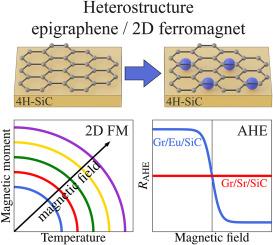外延石墨烯与单层磁铁集成
IF 11.6
2区 材料科学
Q1 CHEMISTRY, PHYSICAL
引用次数: 0
摘要
在石墨烯中嵌入磁性是其在自旋电子学中的重要一步。一种积极探索的方法是石墨烯与二维磁铁的近距离耦合。在这些努力中,外延石墨烯的使用可能会带来显著的优势,因为它比剥离的石墨烯优越,并且与衬底自然集成,但获得磁性的问题仍然存在。在这里,我们报道了一种异质结构耦合外延石墨烯的合成和分析,该外延石墨烯具有由Eu嵌入形成的磁性原子的规则晶格。磁化测量显示材料具有易平面二维磁性,转变温度由低磁场控制。石墨烯中载流子的自旋极化导致负磁阻和反常霍尔效应的出现。在顺磁相,石墨烯的磁电阻表现出感应磁态的临界指数行为。嵌入不损害母体电子结构-石墨烯中电阻率的量子振荡表现为低质量载流子。该结果与基于插层非磁性sr的同结构材料的结果相反。总体而言,该研究扩展了二维磁体的家族,并为石墨烯基自旋电子学建立了一种有前景的材料。本文章由计算机程序翻译,如有差异,请以英文原文为准。

Epitaxial graphene integrated with a monolayer magnet
Imprinting magnetism into graphene makes an important step to its applications in spintronics. An actively explored approach is proximity coupling of graphene to a 2D magnet. In these endeavors, the use of epitaxial graphene may bring significant advantages due to its superiority over the exfoliated counterpart and natural integration with the substrate but the problem of attaining magnetism persists. Here, we report synthesis and analysis of a heterostructure coupling epitaxial graphene with a regular lattice of magnetic atoms formed by Eu intercalation. The magnetization measurements reveal easy-plane 2D magnetism in the material, with the transition temperature controlled by low magnetic fields. The emerging negative magnetoresistance and anomalous Hall effect point at spin polarization of the carriers in graphene. In the paramagnetic phase, the magnetoresistance in graphene exhibits critical exponential behavior of the induced magnetic state. The intercalation does not compromise the parental electronic structure – quantum oscillations in the resistivity manifest low-mass carriers in graphene. The results are set against those for an isostructural material based on intercalated nonmagnetic Sr. Overall, the study expands the family of 2D magnets and establishes a prospective material for graphene-based spintronics.
求助全文
通过发布文献求助,成功后即可免费获取论文全文。
去求助
来源期刊

Carbon
工程技术-材料科学:综合
CiteScore
20.80
自引率
7.30%
发文量
0
审稿时长
23 days
期刊介绍:
The journal Carbon is an international multidisciplinary forum for communicating scientific advances in the field of carbon materials. It reports new findings related to the formation, structure, properties, behaviors, and technological applications of carbons. Carbons are a broad class of ordered or disordered solid phases composed primarily of elemental carbon, including but not limited to carbon black, carbon fibers and filaments, carbon nanotubes, diamond and diamond-like carbon, fullerenes, glassy carbon, graphite, graphene, graphene-oxide, porous carbons, pyrolytic carbon, and other sp2 and non-sp2 hybridized carbon systems. Carbon is the companion title to the open access journal Carbon Trends. Relevant application areas for carbon materials include biology and medicine, catalysis, electronic, optoelectronic, spintronic, high-frequency, and photonic devices, energy storage and conversion systems, environmental applications and water treatment, smart materials and systems, and structural and thermal applications.
 求助内容:
求助内容: 应助结果提醒方式:
应助结果提醒方式:


